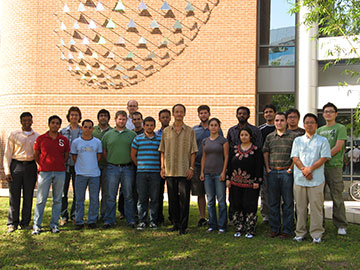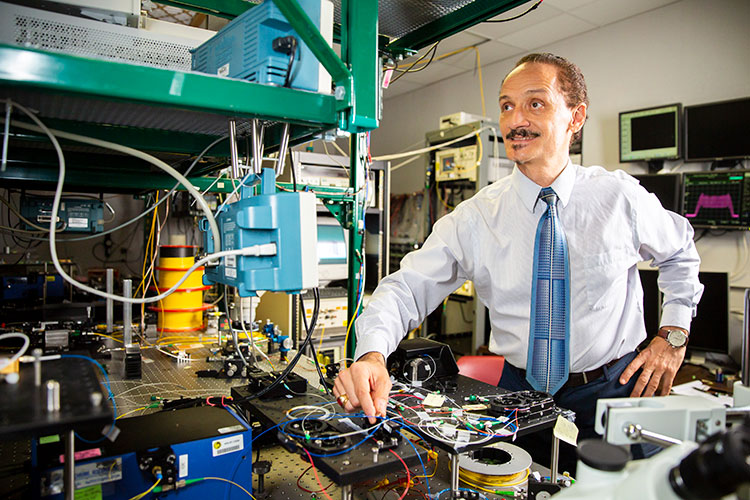
Peter Delfyett in his lab at CREOL. [Image: Courtesy of P. Delfyett]
Editor’s note: In an upcoming feature article in its May 2023 issue, “Breaking Barriers, Advancing Optics,” Optics & Photonics News profiled six Black scientists in the United States, their pathbreaking work in optics, photonics and related areas, and their perspectives on progress and challenges for underrepresented groups in science. In this special accompanying online “Conversations” series, we offer edited versions of the interviews behind those profiles.
In this installment, OPN chats with Optica Fellow Peter J. Delfyett, UCF Distinguished Professor and Pegasus Professor at CREOL, the College of Optics and Photonics at the University of Central Florida, USA.
Tell us about what drew you to science—some of your early inspirations?
Peter Delfyett: I think I can go back as far as, probably, when I was in kindergarten. My grandfather would sit me on his knee, and I would read the New York Times to him as an exercise. He would say, “Peter John, come sit here and let’s read the science articles in the New York Times.”
And what I found sort of fascinating were articles about dinosaurs—as most kids do. So early on I thought I would maybe be a paleontologist. And the reason it was so intriguing was that … I was a good kid, and would go to the church and go to Sunday school, and we’d learn about Adam and Eve and Noah’s Ark. And I was like, “Well, where were the dinosaurs?” As a kid, you ask the hard questions.
“I was a good kid, and would go to the church and go to Sunday school, and we’d learn about Adam and Eve and Noah’s Ark. And I was like, ‘Well, where were the dinosaurs?’ As a kid, you ask the hard questions.”
And so I knew there was something more than just what you would get in Sunday school. That sort of led me down the path of being interested in science. And as I went along, through elementary school, and in junior high school and high school, it always seemed as if science was actually, in some ways, similar to gym, when you went outside to play—science is the time to play at the desk.
OK, you started with paleontology—but you ended up in EE?
Well, I was always good in math and science. When I got into high school, though, I was actually reasonably decent in music, and I wanted to go to school for music. But I was getting a lot of advice and guidance from all of the family relatives, and so I went to school for electrical engineering—it was like, “Okay, let’s try that.”
But as I got further along, I can recall looking at a course catalog one Friday night, maybe starting my third year as a junior in college. And I took a look at the technical electives, and saw one course—“Introduction to Lasers and Masers.” And one of the last things it said in the course description was “This class will also teach the introductory and fundamental concepts of fiber optic communication.”
And I said, that field right there is going to be the thing of the future. And if I were to get a Ph.D. in this area, this will carry me through a career. And so it has!
This was at City College of New York, where you did your bachelor’s degree. I understand you also met a very influential mentor there.
Yes. When I looked at the prerequisites for [the lasers] course, it suggested that I take a class in the physics department called Modern Optics. So I took that class, and I met the guy who wound up being my Ph.D. advisor. That is Robert Alfano, the discoverer of the supercontinuum laser source.
And I went into his class on the first day, and we just seemed to resonate. He seemed like a regular guy, like he could be one of my uncles. And that really gave me a feeling that you actually could be sort of a real world-class scientist in a way that did not fit the canonical mold of someone who wore the white lab coat and spoke a language you just could not understand.
What else did you take from that mentoring relationship? What sort of things did you learn?
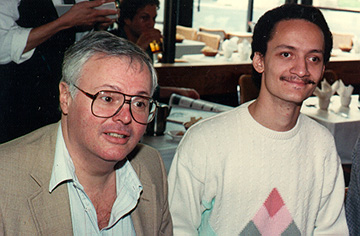
Peter Delfyett (right) with grad-school mentor Robert Alfano, City College of New York. [Image: Courtesy of P. Delfyett]
What I learned from my advisor—many, many things. Think big. Remove the blinders; try and capture the big picture.
But maybe most important, even if you’re thinking about lots of things, he always taught me how to dig deep and focus. As a young energetic guy, I was like, “Oh, Professor Alfano, we could do this, we could do that, we could do the other thing,” all over the place. And he said, “This is great. But we need to focus, channel that energy.”
And also, he taught me to be practical in some sense. I can sum up that lesson with a phrase—“Don’t buy the yellow rug.”
“Don’t buy the yellow rug”?
I was getting ready to graduate. And I had the opportunity to go to Hughes Research Lab, Bell Laboratories in Holmdel, NJ, or Bell Communications Research—Bellcore—right down the road in Red Bank. And [Alfano] said, “Well, you know, I can’t tell you which one to do. But I will tell you a story.”
And he said when he was young and just married, he and his wife went to the store, and they were going to buy a rug for the house. And they saw this absolutely beautiful, fantastic-looking yellow rug, and they just emotionally wanted this thing so bad. So they were going to spend a lot of money for it.
But Professor Alfano’s father in law said, “Well, look, you know, this thing looks great now. But after it’s in the house for a couple of years, you’re gonna walk on it; it’s gonna get dirty; you’re gonna have a real hard time cleaning this thing out.” And so while emotionally, you know, you’re attached to a thing, you need to think without emotions and try to come up with your best decision long term that’s going to be best for you.
So he taught me “don’t buy the yellow rug”—focus; think logically; try to remove the emotion from decisions.
You mentioned going to Bellcore. How do you feel that experience shaped your career?
When I was a graduate student, I did ultrafast laser spectroscopy, looking at phonon physics in organic liquids, in condensed matter, semiconductors, ionic solids, etc., etc. So I was a nonlinear laser spectroscopist. And that sounds like optical physics, even though all of my degrees are in electrical engineering. Even as a grad student, though, I was thinking about how these interesting experiments in optical physics could ultimately lead to interesting applications in 3D TV, fast switching, whatever.
So I went to Bellcore. And they wanted me to work on ultrafast semiconductor lasers—something very different from what I had done. So I remember asking one of the famous scientists, Peter Smith, who was my immediate boss: “I’m just curious. Why do you think that I would be good for this particular position? Because I’ve never done that before.”
And he said, “Well, you have a very good foundation and expertise and ultrafast optics, and a good foundation in nonlinear optics. And those are the two fundamental ingredients we think a person needs to have to be successful on this project.”
“I’ve gone down that path of utilizing ultrafast photonics with semiconductor devices for applications in communications and signal processing. And I’ve been playing in that arena for the past 35 years.”
I was rather impressed that they had the foresight to see that in me. And so I embarked on this new area, which I knew was particularly difficult—some of my other young colleagues were saying, “Oh, my God, that’s such a hard topic; there are so many dead bodies down that path.” But I thought, “I’m going to grab the bull by the horns, and either it’s going to gore me or I’m going to be successful. Let’s give it a try.”
And so that really shaped my career, because I’ve gone down that path of utilizing ultrafast photonics with semiconductor devices for applications in communications and signal processing. And I’ve been playing in that arena for the past 35 years.
That sounds like a great experience—why did you leave Bellcore?
I think I joined Bellcore in 1988. And I think in my third year there, things were going very, very well for me, and I said, “Gee, I feel secure; things are going great; I can buy a house.” And I closed on the house on September 29, 1991. And I think one week later, October 8 or so—I hadn’t even made my first mortgage payment—the area vice president came in and said Bellcore would no longer be doing materials and device research.
That was sort of the start of a transition in what Bellcore was doing. I hung on for the next two years. But a lot of the scientists that were my colleagues were all leaving for academic positions … And I recognized that an organization that has a reputation really builds that reputation based on the people that are there. The bricks and mortar may stay the same, but when the people move on, the organization does change.
And so you looked toward academia?
I was trying to think about my long-term career objectives. I liked doing research; it was great, I had fun doing it ... I had always thought about being an academician, but the concept was, I’m going to stay in industry as long as possible. And if the time presents itself [to move to academia], maybe I’ll think about it at that time.
Well, the time did present itself—after five years [at Bellcore], I thought, This is probably a good time to think about making that move.
I had spent part of my career up at Rochester—the “snow belt” of New York. I knew University of Arizona, in the sun desert. And CREOL—that was the new place, that was the new, young place down in Florida.
Peter Delfyett (center) and members of his team at CREOL, September 2008. [Image: Courtesy of P. Delfyett] [Enlarge image]
And I thought, “Gee, that would be a great place to go.” Not just because of the warm weather and sunshine, but because it was new. Maybe, if I was a new faculty member at a new institution, if it were to grow in stature and size, it might enable me to grow in stature and size as well—and, after many years, I might have the ability to help steer the organization, as opposed to being part of a huge electrical engineering department where I might be just one spoke in a massive wheel.
Only a few years after you went to CREOL, you got the US National Science Foundation’s Presidential Early Career Award for Scientists and Engineers. That must have been an immense confidence builder.
For sure—at that time in my career, that was by far the biggest thing that had ever happened to me. It really helped “put me on a map in some small sense.”
But what I wanted to also do, besides that, was not to just to sit back and say “Oh, look, isn’t that great?,” but to say, “This could be a springboard to really propel my career.” … I have heard senior faculty say that big awards for young faculty like that have the potential to be the kiss of death. You get one of these awards and you sort of rest on your laurels. I wanted to make sure that I didn’t fall into that trap.
Let’s talk about your science. You’ve been involved in some really fantastic work—mode-locking of semiconductor lasers; communications applications; much more. What are the things you’ve led or worked on that you personally feel have had the biggest impact?
A number could probably qualify. But one of them maybe stands out. We came up with a technique in which we were trying to use short bursts of light from semiconductor lasers to drill holes in matter—diamond, metal, whatever it is. We were tasked to do this by DARPA [the US Defense Advanced Research Projects Agency].
And when they come to you and say, “Gee, can you take your short-pulse diode laser and blow holes through walls?,” the obvious answer is, “There is just no way you can do that.” But then you run down the list of important physical roadblocks that prevent you from doing that. And you think about it for a while, and then say, “Well, wait a second—if I can solve those roadblocks, maybe it is possible.”
So we came up with a technique, which we called X-CPA—extreme chirped-pulse amplification. It builds upon the concept of chirped-pulse amplification that won Donna Strickland and Gérard Mourou the Nobel Prize. However, in our case, we were solving a different problem.
In the conventional case, you stretch the pulse and amplify to prevent damage and nonlinear effects in the laser crystal. But with semiconductor lasers, because the device is like a small capacitor and can’t really store much energy, we figured out if we could stretch the pulse, so its temporal duration is orders of magnitude longer than that time constant, you could get many more times energy in this pulse. For example, if the device stores energy for one nanosecond, but I could continuously pump and then stretch a pulse for 10 nanoseconds and amplify it, I would immediately get 10 times the energy in this pulse.
We had basically engineered around the laws of Mother Nature—we didn’t break the laws; we engineered around them.
And that led, I believe, to the formation of a company.
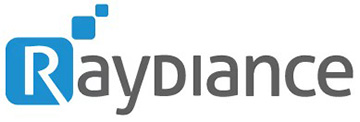
Yes. Once we did that, we were able to compile a bunch of intellectual property—patents for making the short pulses, for doing the amplification, for some applications. And we spun out a company called Raydiance—this was back in the early 2000s. Our first primary investor was Barry Schuler, who had become extremely rich from the AOL–Time Warner merger, and he believed in this technology.
And so we were able to spin this company off. It became successful. It provided lasers to Samsung, for helping to cut Gorilla Glass and improve the yield; to Boston Scientific, for lasers to cut the stents that would go in your arteries; and to Delphi Automotive, where the lasers are basically drilling ultraprecise holes in fuel injectors to make automobile engines much more efficient. It was eventually purchased by Coherent. And the lasers are still out there on the industry floor being used.
What was that experience like—spinning out a company?
You know, spinning out companies—it’s not easy. It’s challenging. Especially because you want to try to avoid conflicts of interest, in terms of the research that you’re doing here at the desk, versus the technology that is being spun out … While we may be spinning out a company, the university is in fact my employer. So you have to make sure that you handle all of those details properly.
Spinning out a company is also like working on multiple DARPA contracts at once, because you have the investors expecting you to perform miracles in short periods of time, with the small amounts of money that are provided. It’s challenging; it’s high pressure; the time schedules are short.
But we did a good job. I was able to graduate several Ph.D. students who went to work for Raydiance, and that helped get the company off the ground, because these guys were well trained and could hit the ground running right away. I think that helped to make the company successful.
I’d like to branch into a few other areas. One is public policy, in which you have a long-standing interest. What are your thoughts about the importance of engagement by scientists like yourself in public policy?
It’s very interesting that you should mention that. For sure, public policy is very important. It’s always very important to be able to educate not just the public, but the politicians in the importance of science, because they’re the guys that are sort of voting and pulling the trigger and pulling the voting switches in terms of whether we’re going to get money for research or education.
I can recall going to a Congressional Visitors Day—and I think I was representing OSA [now Optica]—and talking to the congressional representative for our area, in central Florida. And I talked with him about the importance of investing in science. Because there is a “well of knowledge,” and if you continue to go in with your scoop, and scoop out knowledge to advance technologies, this is great. But if you do nothing to replenish the well, eventually that well dries up.
“There is a ‘well of knowledge’ … [And] if you do nothing to replenish the well, eventually that well dries up.”
There was recently an article published in Nature, which concluded that the level of innovation in scientific publications has dropped. And everyone is scratching their head—why is this? And I’m saying, it’s obvious. If you do not replenish the well, and there’s nothing in there, the innovativeness is going to start to dwindle. That is what I think this Nature paper was pointing to—everything is now short-term investment for research; there’s not a lot of long-term investment in research.
I think this is one result of a lot of the industrial research labs sort of disappearing, and the government not funding that kind of research in academia. Because academia was looked at to take the place of the industrial research labs. And now the chickens are coming home to roost.
Let’s talk a bit about the experience of Black physicists and physicists from underrepresented communities. From your own experience, what are the most important factors in supporting students from these communities?
There are really three important factors—education, research and mentoring.
First off, let’s talk about the education component. Many times, students from underrepresented groups may not have had the opportunity to go to a fancy prep schools or whatever else—they’re being educated in public school districts, and we know that public funding for different school systems vary based upon the tax base that people live in.
So students may get to college or graduate school, and some of their academic skills may not be as proficient as those of other folks. Having a way to address those issues is very important—whether that’s through additional educational support , peer-to-peer tutoring, student networking or something else. Something that helps the students get through the program—instead of operating in a mode where the goal is to see how many students we can prevent from getting through this filter. That was the sort of the philosophy back when I was an undergraduate, and I think it’s important to change that philosophy.
The second component, the research, is also very important. If you are a grad student, and you get a research project in which it looks like you’re just going to be off in the corner, spinning your wheels, with nothing good coming out of it, you feel like an outcast. Being able to work on a project that has meaning, on the other hand, lets you know that your advisor has confidence in your abilities, and makes you feel like you’re contributing to the overall mission of the group. That sense of community is extremely important.
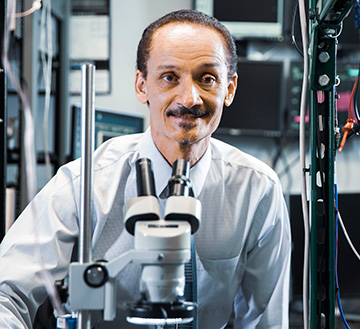
Peter Delfyett. [Image: Courtesy of P. Delfyett]
And then there’s the mentoring component. This is important—for students to be involved in things like the professional societies, in student groups. It’s really helping to build a network. And that is very important. Because as you start to build a network, then you have the opportunity to start being involved not just in the professional society, in student activities at your university, but eventually, you might start playing a role in developing or suggesting technical speakers for [conferences]. You’re starting play a role in shaping some of these activities. In developing a network of people, you have an opportunity to learn from other mentors and their experiences, how to navigate your way through.
You were the president of the National Society of Black Physicists (NSBP) for four years. What did you learn in that role?
What did I learn from being a president of NSBP? Managing an organization is hard. Managing a nonprofit organization is harder. And managing a nonprofit professional organization where the number of members is very small—because the number of Black Ph.D.s in physics [still is very small]—becomes even harder. There is never really a good financial base that you can use to do things with big impact, because that requires investment.
One thing I would say is that—again, I was trained as an electrical engineer. And I think that while an organization like NSBP likes to focus on students primarily in physics, there is some utility in casting the net wider. There are people in engineering and in other areas of science—whether it’s biophysics, or whether it’s areas of mechanical engineering or electrical engineering—whose work is very much related to physics.
So it’s useful to cast the net wider, to be able to grab some of those people and bring them into the community to help grow our numbers.
An organization like Optica has a much larger membership base than NSBP. Given that, is there anything that you think such larger societies can or should do to help increase that representation and provide some of that support?
Sure. As a matter of fact, I was on the recent rapid-action committee with Optica on this. And we came up with a list of possible programs and projects, which we then tried to prioritize in terms of what’s do-able, what would require funding, etc.
And I think Optica has done very well in bringing that list of programs back to the Board to get approval for funding. And more important, Optica has already started to implement some of those programs. So I would like to commend Optica for seeing the need for those things to be done, putting together a task force to help come up with recommendations, and then taking those recommendations, bringing them to the Board and actually getting those things funded and started.
As you noted earlier, physics is often cited as an area where Black scientists are particularly underrepresented. Do you feel that’s changing?
Yes. You know, decades ago, many organizations recognized the strength of diversity in STEM. And people have been working on building and improving the pipeline for decades. And for sure, it is definitely improving. What I tend to find, though, is that many young students coming from underrepresented areas wind up going into the engineering disciplines as opposed to physics.
One final question—what are you working on now that you find especially exciting?
Right now, I’m working in the general area of “short-pulse technology on the head of a pin.” And we’re trying to utilize these devices for high-speed data interconnects.
“Right now, I’m working in the general area of ‘short-pulse technology on the head of a pin.’ ”
One of the big programs that I’m working on now is called PIPES—Photonics in the Package for Extreme Scalability—which is funded by DARPA. We’re trying to develop technologies for data centers that would allow us to transmit and transfer hundreds of terabits per second, from silicon-photonics technology that could fit onto [a chip] about the size of a thumbnail. We’re shooting for metrics of about five terabits per second per millimeter squared—about one watt of power consumption, for data interconnects between 3 and 10 meters.
As these types of technologies become cost effective, they reduce power consumption. Because, as you know, data centers are some of the biggest hogs of power, and they create some of the biggest liabilities for climate change as data centers continue to grow.
Another thing we’re trying to use this short-pulse technology for is biological imaging. Stefan Hell won the Nobel Prize in 2014 for super-resolution microscopy, down to the few-nanometers level. But that uses mode-locked lasers occupying multiple 10-foot tables. We’re showing how we can put these mode-locked lasers on small semiconductor laser chips, where you could potentially fit something like that in a cellphone.
And then you could potentially have a device like Dr. McCoy does on Star Trek, where he says, “Oh, what’s that spot?” And he scans it and he knows exactly what you have.
So you’re working on a “tricorder.”
That’s right! We’re working on the earliest modalities of the tricorder.

